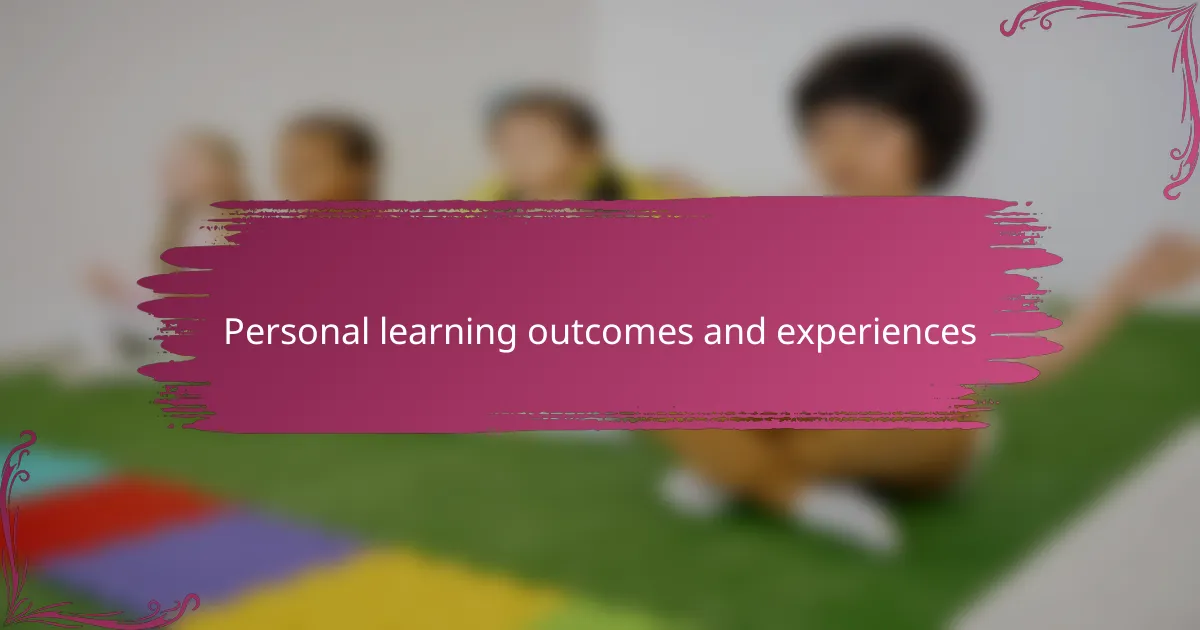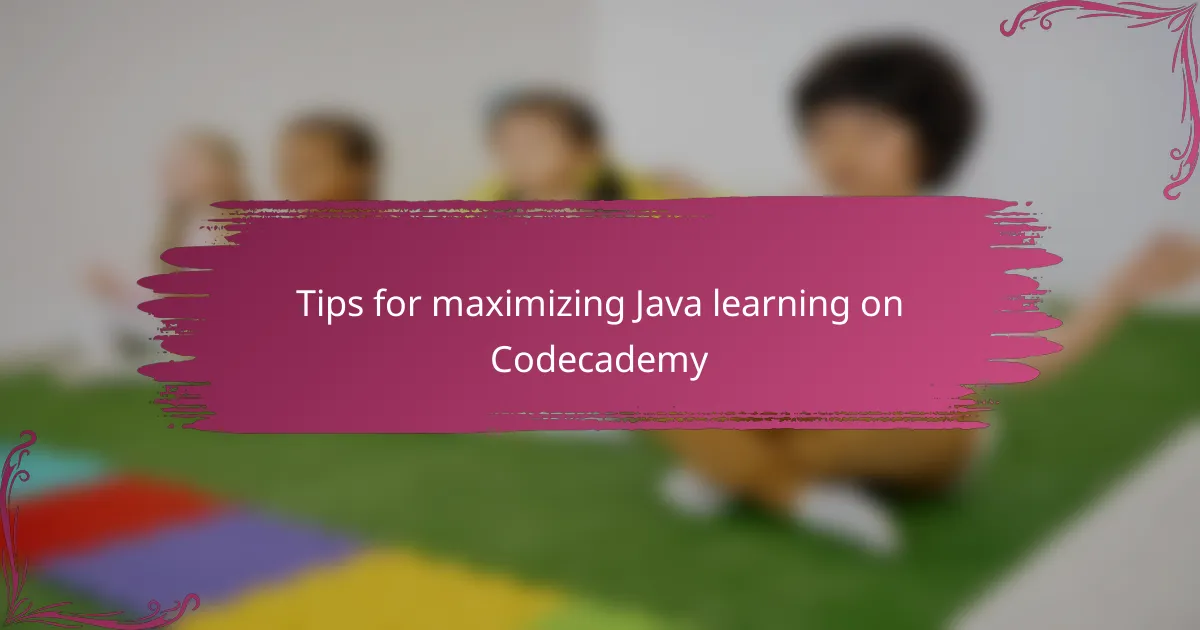Key takeaways
- Java’s platform independence and object-oriented nature make it beginner-friendly yet powerful for larger projects.
- Codecademy’s interactive platform offers immediate feedback, helping learners correct mistakes and maintain motivation.
- Balancing theory with practical projects enhances understanding and retention of programming concepts.
- Experimentation, revisiting lessons, and seeking explanations outside the platform can deepen learning and improve problem-solving skills.

Introduction to programming tutorials
Programming tutorials are more than just lessons; they’re gateways into a world of problem-solving and creativity. I’ve often found myself feeling both challenged and excited, wondering if I can actually transform lines of code into something meaningful. Have you ever felt that mix of curiosity and hesitation when starting to learn something new? That’s exactly where tutorials step in, providing support and guidance every step of the way.

Overview of Java programming language
Java always struck me as a fascinating language because of its “write once, run anywhere” promise. It’s designed to be platform-independent, which means your code can work on different devices without much hassle. Have you ever wondered how apps stay consistent across your phone, laptop, or even smart TVs? Java’s portability is a key reason.
When I first dived into Java, I was surprised by its balance between being beginner-friendly and powerful enough for big projects. Its syntax is clear but also enforces good programming habits, which helped me build a solid foundation early on. Plus, Java’s object-oriented nature encourages thinking about problems in a structured, modular way, which I believe is essential for any programmer.
The vast ecosystem around Java is something I truly appreciate. From frameworks to libraries, there’s a tool for almost every task, making it easier to bring ideas to life. It can feel overwhelming at times, but knowing that millions of developers have walked this path before provides a comforting sense of community and shared resources. Have you noticed how that support can make learning feel less lonely?

What Codecademy offers for Java learners
Codecademy offers an interactive path for learning Java that really clicked with me. The platform breaks down complex concepts into bite-sized exercises, which made practicing feel less like a chore and more like solving little puzzles every day. Have you ever experienced that satisfying “aha” moment when a tough problem suddenly makes sense? Codecademy does a great job guiding you to those moments step-by-step.
What stood out to me was the instant feedback system. As soon as I entered code, I could see whether it worked or needed tweaking. This immediate response helped me correct mistakes early instead of getting frustrated hours later. It felt like having a patient tutor right next to me, encouraging me to try again without fear.
Another thing I really appreciated was the structured curriculum that covers everything from basics to intermediate topics like object-oriented programming. The blend of theory and hands-on projects kept me engaged and gave me confidence to apply what I learned beyond the lessons. Have you noticed how tackling small projects can turn abstract knowledge into real skills? That’s exactly what Codecademy emphasizes for Java learners.

Advantages of learning Java with Codecademy
One of the biggest advantages I found while learning Java with Codecademy was how approachable the lessons felt. Each concept was broken down into manageable pieces, so I never felt overwhelmed. Have you ever started a course only to feel lost within minutes? Codecademy’s pacing helped me stay confident rather than confused.
The instant feedback feature was a game-changer for me. Seeing my code evaluated right away made me think differently about mistakes—not as failures but as stepping stones. It was like having someone gently guide me every time I hit a snag, which kept my motivation alive even when things got tricky.
I also really liked how Codecademy blends theory with practical projects. It’s one thing to learn syntax, but applying it in small challenges made the knowledge stick. Don’t you find that doing creates deeper understanding? That hands-on approach made Java feel less like abstract rules and more like a toolkit I could actually use.

Challenges faced during the Codecademy Java course
Sometimes, I struggled with the pace of certain lessons in the Codecademy Java course. There were moments when concepts like inheritance or interfaces felt a bit rushed, leaving me scrambling to keep up. Have you ever felt that sudden jolt of confusion right in the middle of what should have been a straightforward tutorial? It’s both frustrating and motivating at the same time.
Another challenge was adapting to the strict syntax rules Java enforces. I remember spending almost twenty minutes hunting down a missing semicolon or curly brace that caused my code to fail. It made me realize how important attention to detail is in programming, but it also tested my patience early on. Do you find yourself double-checking every character when learning a new language?
Finally, while Codecademy’s instant feedback is incredibly helpful, it occasionally didn’t provide enough explanation for why my code was wrong. I’d get a hint that something didn’t work, but understanding the root cause sometimes meant stepping outside the platform to consult documentation or forums. Have you ever wished for a bit more hand-holding when stuck? Those moments pushed me to become a more resourceful learner, even if they felt overwhelming initially.

Personal learning outcomes and experiences
When I reflect on my journey learning Java with Codecademy, one thing stands out clearly: the sense of accomplishment after solving each coding challenge. It’s like piecing together a puzzle where every correct line of code brings a little spark of joy. Have you ever felt that thrill when your program finally runs without errors? That feeling kept me coming back, eager for the next lesson.
There were moments when I realized how much my problem-solving skills improved—not just in programming, but in thinking logically and breaking down complex tasks. I remember tackling an exercise on loops and suddenly understanding how to apply similar thinking to real-life scenarios, like organizing my daily schedule. Does learning a programming language sometimes change how you approach everyday problems? For me, it definitely did.
Of course, the journey wasn’t all smooth sailing. Sometimes the instant feedback felt like a double-edged sword—it nudged me to try again, but also made me impatient when I didn’t immediately see what went wrong. I found that stepping away for a short break helped me return with fresh eyes and a clearer mind. Have you noticed how a little pause can turn frustration into insight? This experience taught me not only Java but also patience and perseverance.

Tips for maximizing Java learning on Codecademy
One tip that really made a difference for me was to take full advantage of Codecademy’s interactive exercises. Instead of rushing through the lessons, I made a habit of experimenting with the code snippets—tweaking values or adding my own lines to see how the output changed. Have you ever noticed how hands-on playing around with code can suddenly turn confusion into clarity? That trial-and-error approach helped me internalize concepts much better than just passively reading.
Another strategy I found invaluable was revisiting lessons after completing the entire course. Going back to earlier modules with fresh eyes and more experience allowed me to catch details I initially missed. Sometimes a concept that felt fuzzy at first suddenly clicked during review. Have you ever tried reviewing material after some time away? For me, it transformed partial understanding into confidence.
Finally, I recommend supplementing Codecademy’s instant feedback by writing down questions or errors that threw me off. Instead of getting stuck or frustrated, I’d pause and research explanations on forums or Java documentation. This practice turned those tricky moments into growth opportunities. Don’t you think struggling through tough spots, then seeking answers, builds stronger learning habits? It certainly did for me.